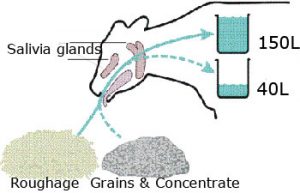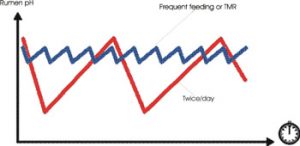
More Saliva Secretion – Healthy Rumen – Efficient Milk Production in Cows
Excessive Saliva Secretion
Based on their digestive anatomy, cows belong to a group of animals known as ruminants. Cows have four stomach compartments, called the rumen, reticulum, omasum and abomasum. The abomasum is the “true stomach”, similar to that of humans. The rumen is the largest compartment and can accommodate 150-200 litres of digestion material and water. While digestion in humans occurs through the breakdown of food by enzymes, digestion in the rumen of cows takes place through the process of fermentation and microbial degradation of feed. Billions of microorganisms, consisting of more than 200 types of bacteria and 20 types of protozoa, attack the feed and fodder. Carbohydrates such as sugar and cellulose are fermented to produce volatile fatty acids and gases. On average, a cow will produce 500 – 1500 litres of gases, 20 – 40% of which is methane.
The production of gases is dependent on the type of feed: fibrous, low energy feed, such as low-quality roughages, would produce more gas, most of which would be methane. A predominant portion of the protein in feed is degraded in the rumen, whereas fats are passed on to the abomasum for enzymatic digestion. Most of the feed is digested in rumen and reticulum.
Why is saliva important?
The feeding behaviour of cows is different than that of other animals, as they eat without any sorting of feed. After a brief period of chewing, the feed, which is mixed with saliva, is swallowed in the form of a bolus. When the cow is not feeding, the feed is returned from the rumen to the mouth for re-mastication. This process is called rumination; the grinding of feed to increase its surface area and thereby facilitate its degradation in the rumen.
 Rumination results in the addition of saliva. For better rumen health, a cow should produce around 150 litres of saliva daily. When cows are fed mainly on concentrate or grain feed, they produce less saliva as low as 50 litres whereas when they are fed on grass or silage, the saliva secretion is higher about 100 – 150 litres. Saliva has two functions, the most important being acting as a buffer. Saliva is alkaline (pH 8.2) due to high sodium bicarbonate levels, and thus prevents deleterious pH changes in the rumen that may be caused by the production of acids and gases.
Rumination results in the addition of saliva. For better rumen health, a cow should produce around 150 litres of saliva daily. When cows are fed mainly on concentrate or grain feed, they produce less saliva as low as 50 litres whereas when they are fed on grass or silage, the saliva secretion is higher about 100 – 150 litres. Saliva has two functions, the most important being acting as a buffer. Saliva is alkaline (pH 8.2) due to high sodium bicarbonate levels, and thus prevents deleterious pH changes in the rumen that may be caused by the production of acids and gases.
Feedstuff like cereals, grains (maize, jowar, barley), potatoes, beetroot, Cassava, molasses, sugarcane, produce more acids when digested in the rumen. Production of acids in the absence of saliva would lead to a shift in rumen pH, which subsequently hampers microbial digestion. Saliva also prevents the frothing that occurs due to the gases produced in fermentation.
When you look at the rumen, the top layer consists of a mat of undigested material which is pushed to the rear by contractions. After rumination, the feed particles are trapped in the mat. Bacteria adhere to the entrapped grounded feed particles. In each rumination cycle, cud from the upper layer is regurgitated. After grinding and mixing with saliva, the cud, which now has an increased surface area, is re-swallowed and pushed to the rear of the rumen, where it is exposed to microbes that digest it. Rumen contractions permit the mixing of the fluid and solid contents in the rumen, stimulating fermentation. With each rumen contraction, gas is also released. Contractions also serve to release gases trapped in either the mat or fluid portion of the ruminal contents.
In each rumination cycle, cud from the upper layer is regurgitated. After grinding and mixing with saliva, the cud, which now has an increased surface area, is re-swallowed and pushed to the rear of the rumen, where it is exposed to microbes that digest it. Rumen contractions permit the mixing of the fluid and solid contents in the rumen, stimulating fermentation. With each rumen contraction, gas is also released. Contractions also serve to release gases trapped in either the mat or fluid portion of the ruminal contents.
The gases are then released by belching. Any disruption in eructation can result in an accumulation of gases, a condition commonly referred to as bloat or tympany. When gas remains entrapped in feed particles, it is called frothy bloat. When the feed particles are brought to the right size they are passed on to the reticulum by ruminal contractions, and then on to the omasum. All these processes require saliva.
Since digestion in the rumen takes place through fermentation, the environment in the rumen is important. For the rumen to be healthy and functional, it needs to be maintained at the right pH. The rumen pH turns either acidic in the case of more grains in feed, or alkaline in the case of the feed comprising more grass or fodder. The mixing of saliva in regurgitated feed is essential. Farmers should make sure the cows are being fed the appropriate type of feed, and also that they have enough space to sit and ruminate thereby ensuring that the cows are producing adequate saliva. It has been observed that every cow has a different lying posture and spends long hours ruminating.
The ideal rumen pH is 6-6.5, as in this range the microbes remain healthy and active. If the pH value varies too much, it results in the elimination of some types of micro-organisms, which consequently affects the digestion of feed. For example, if the rumen pH goes below 6.0, the microbes that digest cellulose (a major component of plant-based feed) do not grow, thereby affecting the digestion of cellulose.
What should farmers do to maintain normal rumen?
- The first feed should comprise long, uncut dry grass. Since it makes the cow chew more, it stimulates salivation. Cow feed should comprise more good quality fodder such as silage or haylage and less concentrate.
- Ensure that cows eat more frequently (10-12 times a day in small portions)
- Enough water should be available as cows consume water every 2-3 hours.
- If the cow is to be fed large amounts of concentrate ration, it should be spread over the day rather than just twice a day. The accompanying graph is an example to explain how rumen pH drifts when cows are fed twice a day. The second graph depicts the feeding of a cow on mixed ration throughout the day. When the feed is made available through the day, the cow can feed voluntarily.
- Do not tie cows, as this may hinder the animal from sitting or lying down comfortably. Cows salivate vigorously while sitting or lying down.
- If cows are not actively eating, they should be sitting or lying down and ruminating with lots of froth coming out of the mouth.
